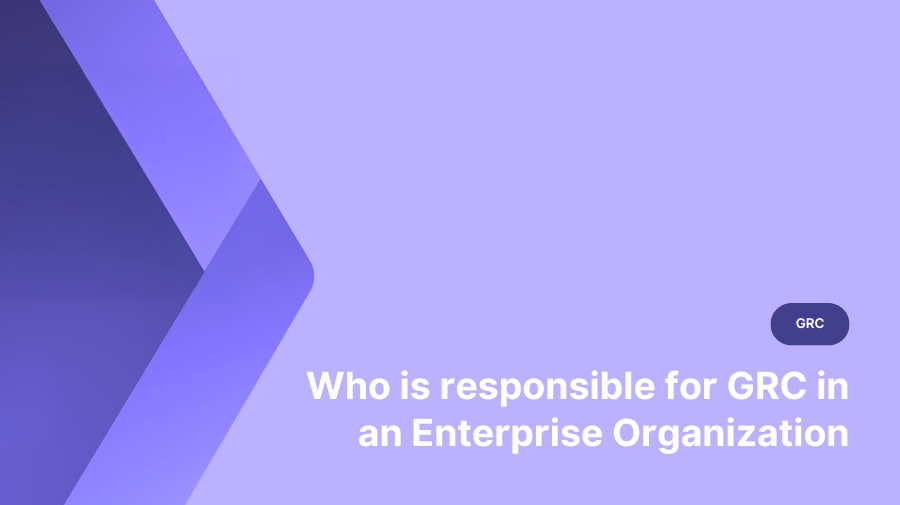
Who is Responsible for GRC In an Enterprise Organization?
In today’s complex regulatory landscape, governance, risk, and compliance (GRC) are crucial components for maintaining a robust, resilient enterprise. But who exactly should oversee GRC within an organization? Many enterprise leaders share roles and responsibilities tied to GRC. We take a look at highlighting the key players and strategies for a successful GRC program.
1. Executive Leadership and the Board
- Role: Ultimate accountability for GRC falls on the C-suite and Board of Directors. They ensure that GRC strategies align with the organization’s vision and objectives.
- Responsibilities:
- Establishing the organization’s risk appetite.
- Overseeing the risk management strategy.
- Setting a culture of compliance across the organization.
2. Chief Risk Officer (CRO)
- Role: In many large enterprises, the CRO leads the risk management strategy and integrates risk awareness into decision-making processes.
- Responsibilities:
- Identifying, analyzing, and mitigating risks.
- Developing risk policies and frameworks.
- Regularly reporting risk assessments to the Board.
3. Chief Compliance Officer (CCO)
- Role: The CCO is responsible for ensuring the organization meets all regulatory requirements and follows internal policies.
- Responsibilities:
- Designing and implementing compliance programs.
- Conducting training on compliance topics for employees.
- Monitoring and addressing compliance risks.
4. Internal Audit Team
- Role: Internal auditors provide independent assessments of how effectively GRC policies are enforced.
- Responsibilities:
- Conducting audits of GRC processes.
- Ensuring compliance with regulatory standards.
- Offering insights for continuous improvement.
5. Business Unit Leaders
- Role: Leaders within different business units ensure that day-to-day operations adhere to GRC standards.
- Responsibilities:
- Implementing GRC policies at the operational level.
- Reporting risks and compliance concerns up the chain.
- Acting as GRC liaisons within their units.
6. IT and Cybersecurity Teams
- Role: These teams protect the organization’s digital assets and data, which are increasingly targeted in today’s threat landscape.
- Responsibilities:
- Implementing cybersecurity frameworks.
- Ensuring data compliance (e.g., GDPR, CCPA).
- Proactively managing and responding to cyber risks.
How These Roles Work Together
Collaboration is essential for GRC to function well in a complex organization. Here’s how these roles support one another:
- Cross-functional communication: Regular updates and meetings ensure that each stakeholder understands the latest compliance and risk developments.
- Risk assessments: Joint risk assessment sessions help align perspectives across departments.
- Unified compliance programs: Integrating compliance efforts reduces redundancy and ensures that all areas of the business adhere to the same standards.
Roles in Complyance
Complyance allows all your team, regardless of their role or involvement, to have access to your GRC setup. This is particularly useful when collaborating across teams.
In Complyance, you can assign role types such as Admin or Member, or even create custom role types that are right for your team, for example Legal Admin or Finance User.
Creating a Successful GRC Framework
For GRC to be effective, it’s not just about assigning responsibilities; it’s about fostering an organizational culture where governance, risk, and compliance are understood and prioritized at all levels.
Here are key strategies for building a successful GRC framework:
- Set a Tone at the Top: Executive leaders should actively promote GRC importance.
- Foster a Compliance Culture: Regular training and open communication ensure everyone understands their role in GRC.
- Invest in Technology: GRC software can streamline processes, manage data, and provide analytics.
- Encourage Reporting and Transparency: Employees should feel comfortable reporting potential risks or compliance issues.
- Continual Improvement: Regularly reviewing and updating GRC policies keeps them relevant and responsive to new challenges.
Why It Matters
In today’s regulatory landscape, companies face more complex risks and compliance requirements than ever before. A robust GRC program helps enterprises to:
- Protect their reputation: Compliance failures can lead to reputational damage that impacts market position and brand trust.
- Avoid costly fines: Regulatory breaches can result in significant fines and penalties.
- Enhance decision-making: A strong GRC framework enables leaders to make informed, strategic decisions.
Effective GRC isn’t owned by any one department or leader; it’s a collaborative effort spanning the entire organization. From executive leadership to cybersecurity teams, each player has a distinct role in building a resilient, compliant enterprise.
By establishing clear responsibilities, fostering a culture of compliance, and leveraging technology, organizations can create a proactive GRC framework that not only mitigates risk but also supports sustainable growth.
Remember, in a world of complex compliance requirements and evolving risks, the question isn’t whether your organization has a GRC program; it’s how well each team member understands and fulfils their role within it.




